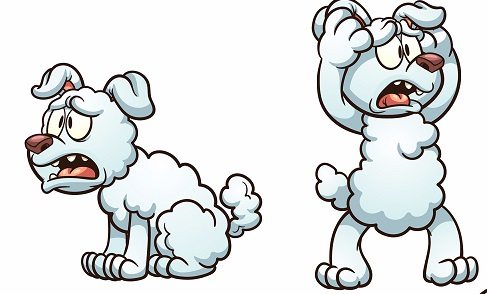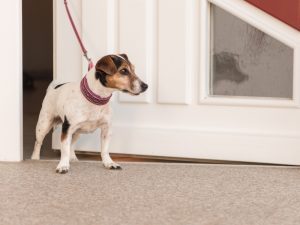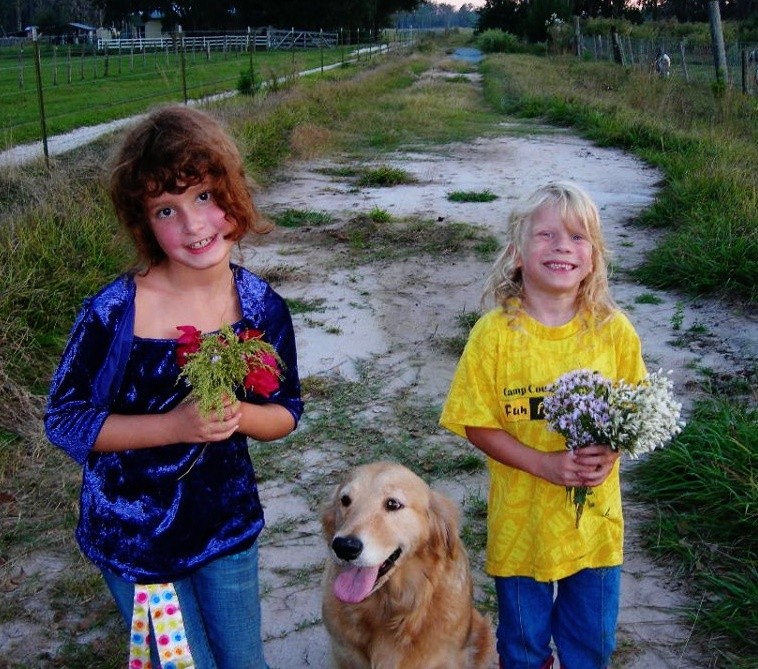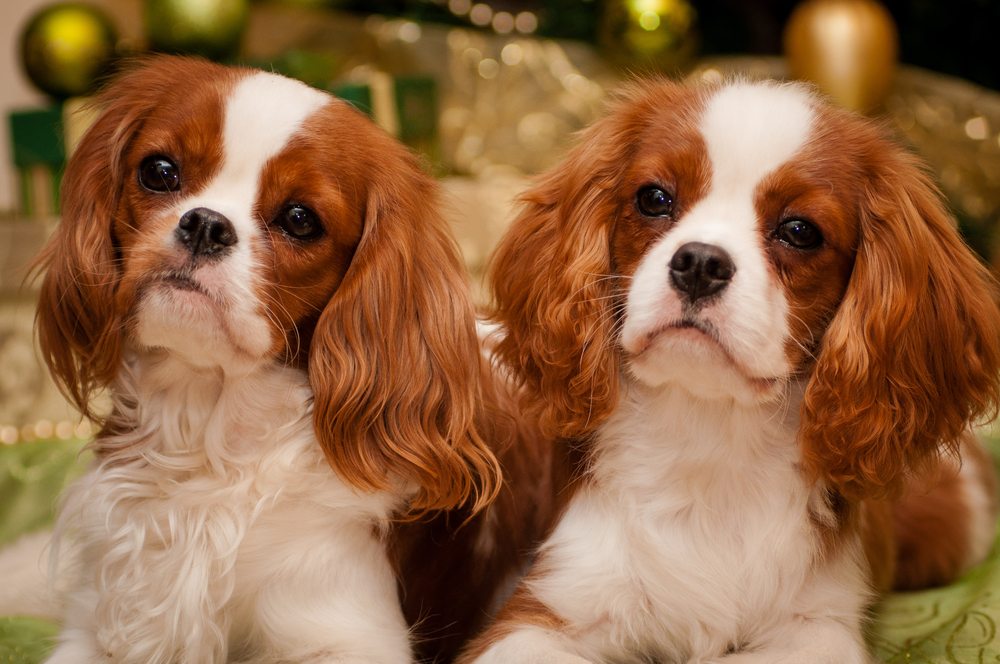Reactive Dog ReactionsA common comment from reactive dog owners came to me.
The Reactive Dog
Such a dog is not truly aggressive; he is what we call reactive. He may be overly stimulated by what is happening around him or he may be afraid or submissive. He might have had a bad experience that led to the reactive behavior, or he might have not been properly socialized as a puppy and young adult. There can be many reasons for reactive behavior, but it’s important to separate it from true aggressive behavior, which stems from dominance. The difference between reactive and aggressive is extremely important to note. Punishing a reactive dog only further convinces him that he should be afraid or startled.Think of it from his point of view. He is already afraid of the man in the hat (if hats are his trigger) and then you pull him back and yell at him. In his mind, his fear of hats is real and now your reaction tells him that he needs to be really afraid of them. Or maybe his trigger is another dog barking at him. You yell, pull back, and maybe even tap his nose to get his attention. The other dog continues barking, probably more aggressively, and your dog is now sure he’s going to be killed. He nips you, rushes at the offending dog, and a fight ensues. Think of it from his point of view. He is already afraid of the man in the hat (if hats are his trigger) and then you pull him back and yell at him. In his mind, his fear of hats is real and now your reaction tells him that he needs to be really afraid of them. Or maybe his trigger is another dog barking at him. You yell, pull back, and maybe even tap his nose to get his attention. The other dog continues barking, probably more aggressively, and your dog is now sure he’s going to be killed. He nips you, rushes at the offending dog, and a fight ensues. Think of it from his point of view.He is already afraid of the man in the hat (if hats are his trigger) and then you pull him back and yell at him. In his mind, his fear of hats is real and now your reaction tells him that he needs to be really afraid of them. Or maybe his trigger is another dog barking at him. You yell, pull back, and maybe even tap his nose to get his attention. The other dog continues barking, probably more aggressively, and your dog is now sure he’s going to be killed. He nips you, rushes at the offending dog, and a fight ensues. A reactive dog is already in a heightened state of mind. He feels out of control and will react to try to find some safety. Some people recognize the fear and pick up their little pet Yorkie who is now trembling with fear at the scary dog towering over him, barking. That confirms in the Yorkie’s mind that yes, the other dog is indeed scary and was trying to kill him when you rushed in to save him; when in fact, the other dog might very well be just asserting his space or dominance (we’ll talk about alpha dogs in another post) Dog Behavior can be learnedYour yorkie has not learned to show submission to the other dog and in fact, acts more like prey than like another dog. The bigger dog continues barking and might even jump to get the yorkie. You hold him tighter and turn away or run away. You have further convinced Yorkie that the other dog is mean and he needs to be afraid. Further, your excited reaction (expressed in your voice, body movements, and other dog read senses) elevates his fear and the other dog’s reaction. Ok, you think, there are many ways not to handle a reactive dog; what should I do?To begin with, think proactively. Anticipate situations that he might cause him to react and have a plan. At the beginning of retraining him, try to keep his environment safe and calm. Work on instilling his confidence in you. Basic obedience training is a good start, but you might not be able to join a group class, if he is reactive to other dogs. A reactive dog is often submissive and desperately seeks the protection of a pack leader. You need to be his pack leader. Pack leaders lead, but don’t stifleHe is not allowed to hide behind you. Instead, he must obey your every command. Set up a calm training environment at the onset. Gradually add distractions a few at a time when he is ready to manage them. Positive reinforcement using words of praise and training treats work well with this type of dog, but should not be so lavishly given that they further distract him; remember, he needs a calm environment. You need to train yourself to remain calm and confident at all times. You may use some corrections, but they should be mild, as well. Often these dogs respond to mostly positive techniques once they accept you as pack leader, but a minor correction of a stern “NO” will be needed occasionally. He needs to see you as the safety net, and any leader has rules that must be followed. In that same idea, giving this type of dog no rules;Don’t allow him free rein of his choices. It’s very unsettling to him and may create more confusion that leads to reactions. It’s easy for an owner to think poor little Tippy is so scared that I just need to let him do as he pleases. Instead, little Tippy needs to know what his parameters are. Make it clear where the boundaries are, and what is expected of him. Give him a job he can do. Then expect him to do it. It might be as simple as retrieving a ball, or perhaps some heeling and sit stays. But he needs to have rules and follow them. It helps him gain confidence and gives you a reason to reward him. When he is just chilling, no reward is given, he is just being calm. Once he begins to grasp training and build confidence at home, it’s time to advance. Take him taken through a few obedience routines and is rewarded as he goes. Over time, he begins to understand the connections and will remain calm for the peaceful feeling it gives him. Crate = Den, Especially for a Reactive DogCrates will be your best friend for this type of dog; not that he should be crated all the time, but that he has a safe den to go to when life is too chaotic for him to expect to manage. Don’t use the crate for punishment and certainly don’t use it all the time, but using it when he needs a safe haven where he can relax is quite beneficial to you and him. If he reacts to company, you might crate him for the first short while when you have people visiting. It can be unsettling to him to have people entering the door, especially multiple times, at first; it’s much easier to introduce him to your company already seated in the living room. Eventually, he’ll learn to welcome your friends at the door, but give him time to learn to adjust to newcomers first. You need to find your calm, cool, collected voice.Dogs are quite intuitive; they will sense calmness, as well as other emotions including agitation, fear, and anger. Strive to portray only calm with your reactive dog. Use a soothing, quiet tone of voice, a steady and gentle hand to pet, and keep your mind set on calm and harmonious. Your dog will read your peaceful emotions and will relax. If you show anxiety or fear, he will react. Keep calm and help him find his calm emotion. Training should also be happy, but calm. Encourage him to continue learning; it’s good for the self-esteem! But insist on a near perfect performance of each concept. Doing so keeps his mind fully occupied and helps him maintain the balance of emotions. His focus is on you. Many times a trainer proves quite helpful, especially in the beginning. An experienced eye watches for actions and reactions and guides you. The right trainer can help you progress through basic training and work into a group class, if you choose. You might even eventually train for other sports such as flyball, agility, or even freestyle. Each of these can offer you both a means of calming and balancing, while finding the confidence your dog needs. Although a reactive dog can be quite a challenge, I find they are usually most perceptive and become close companions, with training and patience. I hope that each reactive dog will find his serenity. It’s up to you as his leader to help him attain that perfect level. Looking for more training ideas to expand your fun with your dog? Mixed breed dogs can join in competitions through the AKC Partners Program. |




